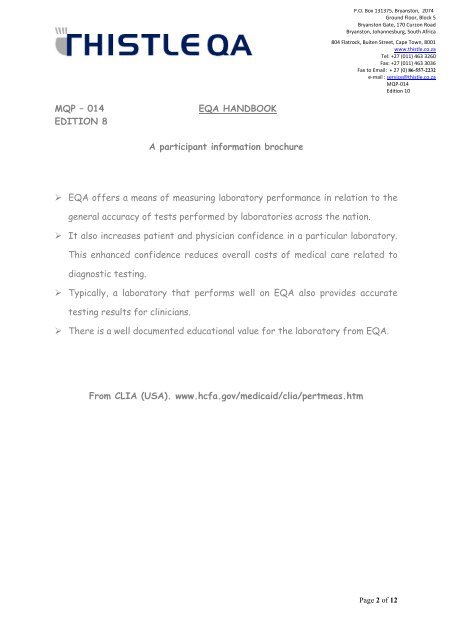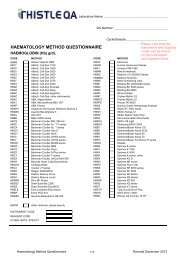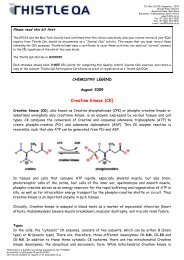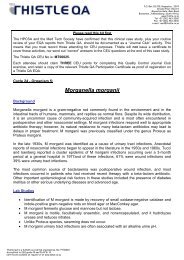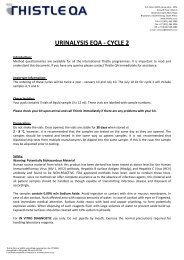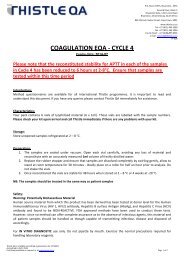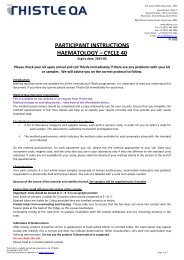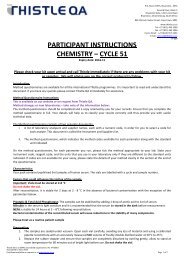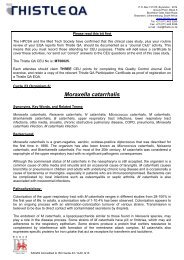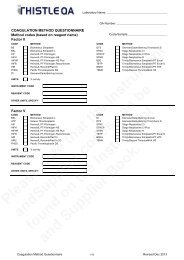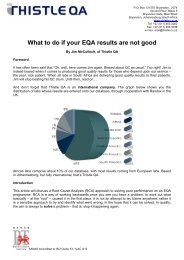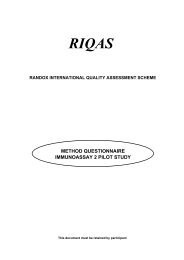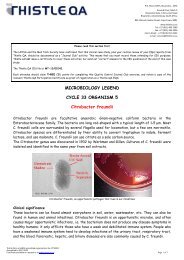MQP â 014 EQA HANDBOOK EDITION 6 A participant ... - Thistle QA
MQP â 014 EQA HANDBOOK EDITION 6 A participant ... - Thistle QA
MQP â 014 EQA HANDBOOK EDITION 6 A participant ... - Thistle QA
You also want an ePaper? Increase the reach of your titles
YUMPU automatically turns print PDFs into web optimized ePapers that Google loves.
P.O. Box 131375, Bryanston, 2074<br />
Ground Floor, Block 5<br />
Bryanston Gate, 170 Curzon Road<br />
Bryanston, Johannesburg, South Africa<br />
804 Flatrock, Buiten Street, Cape Town, 8001<br />
www.thistle.co.za<br />
Tel: +27 (011) 463 3260<br />
Fax: +27 (011) 463 3036<br />
Fax to Email: + 27 (0) 86-557-2232<br />
e-‐mail : service@thistle.co.za<br />
<strong>MQP</strong>-‐<strong>014</strong><br />
Edition 10<br />
<strong>MQP</strong> – <strong>014</strong><br />
<strong>EDITION</strong> 8<br />
<strong>E<strong>QA</strong></strong> <strong>HANDBOOK</strong><br />
A <strong>participant</strong> information brochure<br />
Ø <strong>E<strong>QA</strong></strong> offers a means of measuring laboratory performance in relation to the<br />
general accuracy of tests performed by laboratories across the nation.<br />
Ø It also increases patient and physician confidence in a particular laboratory.<br />
This enhanced confidence reduces overall costs of medical care related to<br />
diagnostic testing.<br />
Ø Typically, a laboratory that performs well on <strong>E<strong>QA</strong></strong> also provides accurate<br />
testing results for clinicians.<br />
Ø There is a well documented educational value for the laboratory from <strong>E<strong>QA</strong></strong>.<br />
From CLIA (USA). www.hcfa.gov/medicaid/clia/pertmeas.htm<br />
Page 2 of 12
P.O. Box 131375, Bryanston, 2074<br />
Ground Floor, Block 5<br />
Bryanston Gate, 170 Curzon Road<br />
Bryanston, Johannesburg, South Africa<br />
804 Flatrock, Buiten Street, Cape Town, 8001<br />
www.thistle.co.za<br />
Tel: +27 (011) 463 3260<br />
Fax: +27 (011) 463 3036<br />
Fax to Email: + 27 (0) 86-557-2232<br />
e-‐mail : service@thistle.co.za<br />
<strong>MQP</strong>-‐<strong>014</strong><br />
Edition 10<br />
What is an <strong>E<strong>QA</strong></strong><br />
<strong>E<strong>QA</strong></strong> is:<br />
Ø An essential part of a quality system for labs<br />
Ø A regulatory requirement for laboratories seeking accreditation through<br />
SANAS<br />
Ø Designed to help labs identify and resolve analytical problems<br />
Ø Part of a laboratory’s accuracy and precision assessment system<br />
What is special about <strong>Thistle</strong> <strong>QA</strong><br />
Ø <strong>Thistle</strong> <strong>QA</strong> was the first organisation in South Africa to gain <strong>E<strong>QA</strong></strong><br />
accreditation through SANAS; firstly according to ISO Guide 43 and more<br />
recently ISO 17043.<br />
Ø Many <strong>E<strong>QA</strong></strong>s are international<br />
Ø Data is stored securely and permanently<br />
Ø Full <strong>participant</strong> confidentiality is assured, unless this requirement is waived<br />
by the <strong>participant</strong>.<br />
Ø We give full in-lab support, with FREE workshops, seminars & bench<br />
consultations<br />
Ø All our teaching carries CPD points.<br />
Ø We do not subcontract any part of our services.<br />
Ø Any changes in a proficiency testing scheme or operation will be<br />
communicated to you via email or published in Quality Matters.<br />
Ø Fees for participation are indicated on the enrolment forms available on the<br />
website or on request from <strong>Thistle</strong>.<br />
Who takes part<br />
Sixteen countries in Africa are enrolled directly in programmes run by <strong>Thistle</strong><br />
<strong>QA</strong>. Our direct database is approaching 4000 laboratories/ instruments.<br />
Both private and state laboratories take part.<br />
Through our data-share facility with Randox (UK) results from 60 countries are<br />
included in our database.<br />
The total database available to labs in Africa through <strong>Thistle</strong> <strong>QA</strong> is now over<br />
22000.<br />
<strong>Thistle</strong> <strong>QA</strong> is truly both local and international<br />
Page 3 of 12
P.O. Box 131375, Bryanston, 2074<br />
Ground Floor, Block 5<br />
Bryanston Gate, 170 Curzon Road<br />
Bryanston, Johannesburg, South Africa<br />
804 Flatrock, Buiten Street, Cape Town, 8001<br />
www.thistle.co.za<br />
Tel: +27 (011) 463 3260<br />
Fax: +27 (011) 463 3036<br />
Fax to Email: + 27 (0) 86-557-2232<br />
e-‐mail : service@thistle.co.za<br />
<strong>MQP</strong>-‐<strong>014</strong><br />
Edition 10<br />
What material is used<br />
We buy the best we can find at the best prices.<br />
Only reputable suppliers are used for our material, which is always designed<br />
with Africa in mind.<br />
The homogeneity and stability of our material is monitored according to the<br />
requirements of ISO 17043.<br />
What can I join and when<br />
Lists of all available <strong>E<strong>QA</strong></strong>s, and analytes covered are available on the website or<br />
on request. The lists are always changing, so call us for an update. Please<br />
contact us as well for advice on eligibility criteria for participation if applicable.<br />
Despite the official starting dates, we almost always have an excess of material,<br />
so you can join any <strong>E<strong>QA</strong></strong> at almost any time. We won’t charge you for a portion<br />
of an <strong>E<strong>QA</strong></strong>, so ask if any material is available for the <strong>E<strong>QA</strong></strong> of your choice. The<br />
official starting dates are as follows.<br />
Immunoassay<br />
Immunoassay Speciality I & II<br />
Lipids<br />
Human Urine<br />
Blood Gas<br />
Liquid Cardiac<br />
Coagulation<br />
HBA1C<br />
Maternal Screening<br />
BNP<br />
Differential Slides<br />
HIV Serology<br />
CSF<br />
Clinical Chemistry<br />
Haematology<br />
Therapeutic Drugs<br />
Human Proteins<br />
Cardiac<br />
CTS (Forensics)<br />
January & July<br />
February & August<br />
March & September<br />
Page 4 of 12
Clinical Microbiology<br />
Pregnancy<br />
ESR<br />
April & October<br />
P.O. Box 131375, Bryanston, 2074<br />
Ground Floor, Block 5<br />
Bryanston Gate, 170 Curzon Road<br />
Bryanston, Johannesburg, South Africa<br />
804 Flatrock, Buiten Street, Cape Town, 8001<br />
www.thistle.co.za<br />
Tel: +27 (011) 463 3260<br />
Fax: +27 (011) 463 3036<br />
Fax to Email: + 27 (0) 86-557-2232<br />
e-‐mail : service@thistle.co.za<br />
<strong>MQP</strong>-‐<strong>014</strong><br />
Edition 10<br />
Food Micro<br />
May & November<br />
Infectious Disease<br />
June & December<br />
How do the <strong>E<strong>QA</strong></strong>s operate<br />
Provided you have enrolled timeously, your kit will be dispatched approximately<br />
2 weeks before the start date of the new cycle. Bear in mind that samples are<br />
imported and there may at times be customs issues which we do not have<br />
control over, but we will however endeavour at all times to get the samples out<br />
to you on time. Your kit usually has enough samples to cover a six month period.<br />
With the kit comes an instruction sheet, method questionnaire and results entry<br />
sheet for you to fill in.<br />
This results entry sheet already has your own unique <strong>QA</strong> Number on it.<br />
Please choose the method of your choice for each analyte listed on the method<br />
questionnaire and return together with your results to enable correct<br />
registration.<br />
In addition, we send you a Participation Certificate.<br />
The instruction sheet has lots of important information and it must be read<br />
carefully. For example,<br />
Ø Dates of analysis, or the final date by which we must receive your results.<br />
Ø Safety and disposal details for handling the sample<br />
Ø Reconstitution or mixing details<br />
Ø The important recommendation that you analyse our samples exactly as if<br />
they were patient samples<br />
Ø Storage details<br />
Ø Factors that could affect the testing if applicable<br />
Ø Environmental conditions<br />
Ø Recording and reporting of results<br />
Ø Contact details for any enquiries<br />
Ø Return policy of samples when applicable<br />
Page 5 of 12
P.O. Box 131375, Bryanston, 2074<br />
Ground Floor, Block 5<br />
Bryanston Gate, 170 Curzon Road<br />
Bryanston, Johannesburg, South Africa<br />
804 Flatrock, Buiten Street, Cape Town, 8001<br />
www.thistle.co.za<br />
Tel: +27 (011) 463 3260<br />
Fax: +27 (011) 463 3036<br />
Fax to Email: + 27 (0) 86-557-2232<br />
e-‐mail : service@thistle.co.za<br />
<strong>MQP</strong>-‐<strong>014</strong><br />
Edition 10<br />
Turn-around times<br />
Most of our <strong>E<strong>QA</strong></strong>s work on a 7-10 working day turn-around-time. This means<br />
your reports are mailed to you or emailed via PDF within 7 – 10 working days<br />
after the final analysis date. Of course, we have little control over postal<br />
delays, but with the PDF system reports can be received a lot quicker. Most of<br />
our reports are available electronically.<br />
What type of reports is distributed<br />
There are few limits to what is available. The routine reports have been<br />
designed to satisfy most of the needs of a busy routine laboratory – but if they<br />
don’t suit you, give us a call. We will design and supply what you need. Roughly,<br />
the following are available.<br />
Ø Weekly lab reports, with Levey-Jennings charts, SDIs and Clinical CVs, and a<br />
historical evaluation.<br />
Ø Group reports for those with anything from 2 to 200 labs or instruments, to<br />
allow easy scanning for problems.<br />
Ø Cumulative reports are also printed monthly for those with many sites to<br />
control.<br />
Ø Management reports are produced monthly, if required, with a brief<br />
summary of overall performance.<br />
Ø Three of our <strong>E<strong>QA</strong></strong>s carry SMLTSA points for CPD, namely Chemistry,<br />
Microbiology and Differential Slides. The relevant information and questions<br />
are distributed with reports monthly.<br />
Currently, results can be sent to us via fax, fax to email, e-mail, from our web<br />
site (www.thistle.co.za) or through direct electronic data dump with certain<br />
groups of labs.<br />
Page 6 of 12
P.O. Box 131375, Bryanston, 2074<br />
Ground Floor, Block 5<br />
Bryanston Gate, 170 Curzon Road<br />
Bryanston, Johannesburg, South Africa<br />
804 Flatrock, Buiten Street, Cape Town, 8001<br />
www.thistle.co.za<br />
Tel: +27 (011) 463 3260<br />
Fax: +27 (011) 463 3036<br />
Fax to Email: + 27 (0) 86-557-2232<br />
e-‐mail : service@thistle.co.za<br />
<strong>MQP</strong>-‐<strong>014</strong><br />
Edition 10<br />
How are results statistically treated<br />
We have three sets of statistical approaches when grouping results in a<br />
database, namely:<br />
Stats Level 1: All results are grouped in the same method group, when the<br />
results are the same regardless of which method is used. This was our historical<br />
default group, and has been changed based on new information from suppliers,<br />
poor distribution of results (high SDs), bimodal distribution of results,<br />
customer comments/ criticisms and AdCom recommendations.<br />
Stats Level 2: Most methods give results within one modal distribution except<br />
for one method, e.g. dry chemistry.<br />
Stats Level 3: Each method is statistically considered separately as none of the<br />
methods available for that test can be compared to any other, e.g. HDL on the<br />
Chemistry <strong>E<strong>QA</strong></strong><br />
a) Participants are permitted to use a method of their choice in analysing<br />
PT/ <strong>E<strong>QA</strong></strong> samples. We use the information supplied to us by <strong>participant</strong>s<br />
on our Method Questionnaire to allocate method groups to <strong>participant</strong>s on<br />
our database, based on the methodology of their chosen method. In<br />
addition, we receive information on the instrument used and this allows us<br />
to allocate the <strong>participant</strong> to an instrument group, comprising labs using<br />
the same methodology on the same instrument. Labs are thus able to look<br />
at both aspects on our reports.<br />
b) This aspect is assessed on an ongoing basis based on continued monitoring<br />
of SDs and information supplied by instrument and reagent suppliers.<br />
We use two different, but complementary systems of performance evaluation.<br />
Firstly, we produce the usual statistical comparisons of mean and Standard<br />
Deviation (SD), sometimes called Standard Deviation Index (SDI). This can only<br />
take place after a data clean up procedure.<br />
We also use robust mean and SD calculations along with Chauvenet's criterion to<br />
exclude outliers, followed by a 95% trim. Chauvenet's criterion is a unidirectional<br />
and highly sensitive system that identifies outliers from the mean<br />
based on the expected SDI for the number of data points. Consecutive passes<br />
are made until the data satisfies the Criterion. At this point, the mean and SD<br />
Page 7 of 12
P.O. Box 131375, Bryanston, 2074<br />
Ground Floor, Block 5<br />
Bryanston Gate, 170 Curzon Road<br />
Bryanston, Johannesburg, South Africa<br />
804 Flatrock, Buiten Street, Cape Town, 8001<br />
www.thistle.co.za<br />
Tel: +27 (011) 463 3260<br />
Fax: +27 (011) 463 3036<br />
Fax to Email: + 27 (0) 86-557-2232<br />
e-‐mail : service@thistle.co.za<br />
<strong>MQP</strong>-‐<strong>014</strong><br />
Edition 10<br />
are calculated and all results, including those excluded by Chauvenet’s Criterion,<br />
are calculated as numbers of SDI away from the mean. Traditionally, this<br />
system is used but has the limitation that 5% of labs will always fall outside the<br />
+/- 2 SD range, whether more or less labs should have been labeled as out of<br />
control. We have noted that the SDIs have tended to fall from the beginning of<br />
our <strong>E<strong>QA</strong></strong> service, thus they are lower now than before. This means that overall<br />
performance, as measured by SDI, has improved. However, the continued use<br />
of SDI means that 5% of labs still are told they are out of control. If the labs<br />
who are outside the 2 SD limit improve their performance, the calculation will<br />
become tighter – and 5% will still be told they have a problem. The SD or SDI<br />
can thus be called a Variable Limit. It changes as performance changes, but<br />
always excludes 5%. It is still useful to use this purely statistical assessment.<br />
If your result falls outside 2 SDs, you are in the poorest 5% of performers for<br />
that test or analyte. This is definitely real and relevant.<br />
We have performed preliminary evaluations of iteration (ISO 13528) to reduce<br />
our outlier exclusion to one system. This was successful and will be rolled out<br />
onto the various <strong>E<strong>QA</strong></strong>s as we re-write our software, planned for 2013.<br />
In addition, we classify results as either poor or acceptable based on a<br />
percentage range about the mean called 'Clinical CV'. We introduced this<br />
concept of “how well we need to do tests for the result to be clinically useful”,<br />
in other words, Clinical Limits. Each analyte has its own Clinical CV, these are<br />
percentage ranges about the consensus mean that are considered acceptable.<br />
The yardsticks we use for these fixed limits are those published in the USA<br />
document CLIA’88 (the Clinical Laboratory Improvement Amendment of 1988),<br />
and Biological Variation. In addition a local group of pathologists has evaluated<br />
these ranges and given us an African Acceptable Clinical Limits range. If your<br />
result is inside these percentage ranges of the consensus mean, it will be called<br />
“Acceptable” on your report.<br />
Esoteric analytes or those with low <strong>participant</strong> numbers are treated<br />
differently:<br />
a) A warning flag will print on the report when the <strong>participant</strong> number is<br />
low.<br />
Page 8 of 12
P.O. Box 131375, Bryanston, 2074<br />
Ground Floor, Block 5<br />
Bryanston Gate, 170 Curzon Road<br />
Bryanston, Johannesburg, South Africa<br />
804 Flatrock, Buiten Street, Cape Town, 8001<br />
www.thistle.co.za<br />
Tel: +27 (011) 463 3260<br />
Fax: +27 (011) 463 3036<br />
Fax to Email: + 27 (0) 86-557-2232<br />
e-‐mail : service@thistle.co.za<br />
<strong>MQP</strong>-‐<strong>014</strong><br />
Edition 10<br />
b) These analytes are monitored at Management Review and will be<br />
discontinued after consideration by AdCom within stipulated time<br />
frames.<br />
How do I use this information<br />
The following advice applies to all <strong>E<strong>QA</strong></strong>s except Microbiology, Differential<br />
Slides, HbA1C and Serology.<br />
Our reports can show the following situations.<br />
1. Your result is classified as Poor and is outside 2 SDs. This is the worst<br />
possible case and means that you are in the worst 5% of performers AND<br />
your result is not within the Clinical Limits as specified by CLIA’88.<br />
Clearly this needs action, which we discuss later in this Handbook.<br />
2. If you are outside 2 SDs with either an Acceptable or Ideal<br />
classification, it means that you are in the worst 5% of performers BUT<br />
your result is within the Clinical Limits. You may not like being in the<br />
worst 5%. However, although this is still a problem worth noting and<br />
monitoring at least, it is obviously less serious than No. 1.<br />
3. If your result is classified as Poor but you are within the 2 SDs, the<br />
opposite applies. You are not in the worst 5% of performers BUT you are<br />
outside the Clinical Limits. How can this happen It means that more<br />
than 5% of performers fail the Clinical Limit, in other words, you are not<br />
alone.<br />
Perhaps your method itself shows a bias or imprecision problem (ask and<br />
we’ll do a query for you), or that the methodology is not good enough for<br />
clinical purposes. This is sometimes the case with certain analytes which<br />
are under tight homeostatic control in the human body, such as calcium,<br />
and thus clinicians use small serial changes in results to confirm<br />
therapeutic efficiency.<br />
As a rule of thumb, category No. 1 is where to apply your attentions, at least to<br />
begin with. Thereafter, other problems become important.<br />
Page 9 of 12
P.O. Box 131375, Bryanston, 2074<br />
Ground Floor, Block 5<br />
Bryanston Gate, 170 Curzon Road<br />
Bryanston, Johannesburg, South Africa<br />
804 Flatrock, Buiten Street, Cape Town, 8001<br />
www.thistle.co.za<br />
Tel: +27 (011) 463 3260<br />
Fax: +27 (011) 463 3036<br />
Fax to Email: + 27 (0) 86-557-2232<br />
e-‐mail : service@thistle.co.za<br />
<strong>MQP</strong>-‐<strong>014</strong><br />
Edition 10<br />
Microbiology is simpler in some ways. The scoring system we use is based on<br />
CLIA’88. If you score more than 80% overall, you have achieved the required<br />
standard. If your score on average is less than 80%, it is fairly easy to see<br />
where you have lost points and investigate. Serology is much more difficult.<br />
The scoring system is based partly on Target Values and mostly on Consensus<br />
Values. It is difficult to say what an acceptable score is, but experience<br />
suggests that the 80% score may well apply here too. Neither of our slide <strong>E<strong>QA</strong></strong>s<br />
have scores, as they are both regarded as largely educational in nature.<br />
Homogeneity and stability<br />
Studies have been performed and data is available on request. Please note that<br />
we are currently changing the way we perform these studies, in line with the<br />
requirements of ISO 17043. In future labs receiving repeat samples will be<br />
asked to agree to send us the new results for this purpose only. We will not<br />
change the results on our database but plan to use the two sets of results for<br />
these studies only.<br />
Traceability<br />
Most <strong>E<strong>QA</strong></strong>s use consensus to establish the target value or mean and thus<br />
traceability is not required. Where the company supplying the material has<br />
target values or supplies CRMs as is the case with the Food Micro programme,<br />
certificates will be available on request. Other than in this instance, no values,<br />
consensus or assigned are disclosed to any <strong>participant</strong> thereby ensuring that no<br />
<strong>participant</strong> gains an unfair advantage from early disclosure.<br />
Uncertainty of the mean<br />
This will be measured according to Algorithm A in Annex C of ISO 17043, and<br />
the mean will be considered valid, with minimal uncertainty, if x is
P.O. Box 131375, Bryanston, 2074<br />
Ground Floor, Block 5<br />
Bryanston Gate, 170 Curzon Road<br />
Bryanston, Johannesburg, South Africa<br />
804 Flatrock, Buiten Street, Cape Town, 8001<br />
www.thistle.co.za<br />
Tel: +27 (011) 463 3260<br />
Fax: +27 (011) 463 3036<br />
Fax to Email: + 27 (0) 86-557-2232<br />
e-‐mail : service@thistle.co.za<br />
<strong>MQP</strong>-‐<strong>014</strong><br />
Edition 10<br />
Where do I start investigating problems<br />
This is never simple. We always suggest, however, checking the simple things<br />
first.<br />
1. Have we got the correct registration details for you Each report shows<br />
the categories or instruments for which you are registered. If this is not<br />
correct, tell us. Do not change anything unless you have taken this simple<br />
step.<br />
2. Have you made a reconstitution or transcription or mixing error Is it<br />
possible that your reconstitution procedure was not followed Could you<br />
have a problem with water quality Are you sure you sent us the <strong>E<strong>QA</strong></strong><br />
sample results – could there have been a transcription error Finally, for<br />
haematology, did you follow the mixing instructions Again, check these<br />
stages before you make any changes.<br />
3. Is the error you see a once-off Do not over-react to a single error on<br />
<strong>E<strong>QA</strong></strong>. Start your investigations, and certainly monitor your procedures,<br />
but do not begin altering calibration factors – not yet!<br />
4. What does your Internal Quality Control (IQC) look like If you have<br />
imprecision on both <strong>E<strong>QA</strong></strong> and IQC, investigate and resolve. If on one<br />
only, investigate and resolve. BUT, if your IQC looks fine, without a bias,<br />
and you have a bias on your <strong>E<strong>QA</strong></strong>, give us a call. We need to discuss the<br />
way in which you integrate your information from your IQC (for<br />
monitoring precision) and your <strong>E<strong>QA</strong></strong> (for assessing accuracy).<br />
5. If this information above is not clear, or does not answer your problem,<br />
either look on our web page, or give us a call. We are here to help.<br />
Page 11 of 12
P.O. Box 131375, Bryanston, 2074<br />
Ground Floor, Block 5<br />
Bryanston Gate, 170 Curzon Road<br />
Bryanston, Johannesburg, South Africa<br />
804 Flatrock, Buiten Street, Cape Town, 8001<br />
www.thistle.co.za<br />
Tel: +27 (011) 463 3260<br />
Fax: +27 (011) 463 3036<br />
Fax to Email: + 27 (0) 86-557-2232<br />
e-‐mail : service@thistle.co.za<br />
<strong>MQP</strong>-‐<strong>014</strong><br />
Edition 10<br />
What if I need to discuss my quality<br />
If you are not happy with our evaluation of your performance, please contact us<br />
either telephonically or via email. We offer lots of friendly help and advice,<br />
from telephonic discussions, to query reports, showing your specific instrument<br />
performance over time. Our database is huge and is there for your support. All<br />
calls are logged on our Epicor Management System and will be resolved within 2<br />
days unless otherwise specified.<br />
REMEMBER: IF IN ANY DOUBT –<br />
GIVE US A CALL<br />
Page 12 of 12


